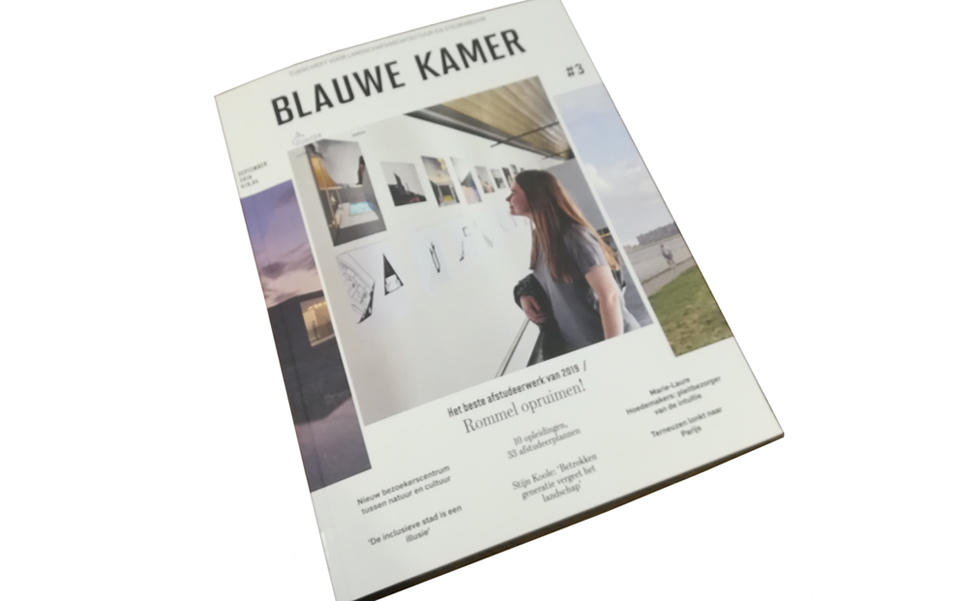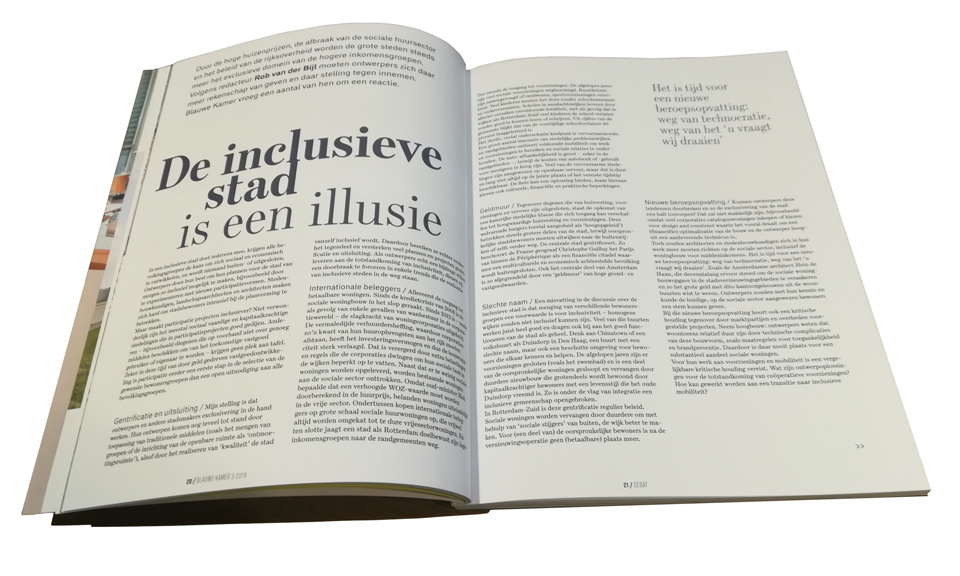[:nl]De Blauwe Kamer stelt in het najaarsnummer de vraag of de inclusieve stad een illusie is. De redacteur Rob van der Bijl beschrijft mechanismen die de stad niet inclusief maken. Hij stelt bijvoorbeeld de participatie aan de kaak. In participatieprocessen krijgen vaak mondige burgers, met voldoende sociale vaardigheden en kapitaal, de aandacht. Andere groepen worden juist niet gehoord omdat zij de weg naar inspraak niet weten te vinden. Als dan uiteindelijk tot ontwikkeling wordt overgegaan worden omgevingen gecreëerd die niet inclusief zijn. Deels veroorzaakt doordat internationale beleggers de prijzen opdrijven of huizen omkatten van sociale naar dure huur. Deels veroorzaakt doordat maatschappelijke voorzieningen en programma’s zijn afgebouwd, zoals buurthuizen en schoolzwemmen, waardoor bewoners minder kansen krijgen. Als laatste wijst hij op de vervoersarmoede doordat de auto nog steeds erg dominant is en de auto voor velen financieel onbereikbaar is. Diegene die wel profiteren is de groep die het economisch gezien beter doet. Rob roept ontwerpers, architecten en stedenbouwkundigen op om deze tendens te stoppen en meer sociaal geëngageerd te zijn.
Robbert-Jan van Veen (Plein06), Jos Gadet (gemeente Amsterdam) en Arna Mačkić (Studio LA) en Pepijn Verpaalen (URBANOS) reageerden op deze stelling. In onze reactie hebben wij ons vooral gericht op wat wij als stedenbouwkundigen kunnen doen aan inclusiviteit en een inclusieve stad. Wij merken dat vaak wordt gekeken naar de verschillen tussen mensen, zoals de etniciteit, leeftijd of opleidingsniveau. Voor ons staat echter de zoektocht naar wat verschillende groepen verbindt centraal om de stad inclusiever te maken.
Hieronder onze reactie.
Stedenbouwkundige Pepijn Verpaalen won met zijn bureau URBANOS een door projectontwikkelaar AM uitgeschreven prijsvraag over de inclusieve stad.
‘Het valt mij op dat het debat over inclusiviteit vaak gaat over verschillen in bijvoorbeeld etniciteit, leeftijd of het opleidingsniveau. Terwijl niemand alleen op die manier getypeerd kan worden. Iedereen maakt deel uit van verschillende subculturen. Ik bedoel: iemand met een migratieachtergrond is ook vader, trainer bij de voetbalclub of verzamelaar van modeltreinen. We richten ons dan ook liever op al die subculturen die de stad rijk is. Het is onze taak om openbare ruimtes te ontwerpen waar subculturen elkaar treffen. De “wrijving” tussen groepen, dat we in aanraking komen met de ander, is cruciaal voor een democratische en inclusieve samenleving: uiteindelijk moeten we het in de stad met elkaar rooien’.
‘Het is dan belangrijk om je te verdiepen in de plek of de wijk waar je aan de slag gaat. Getting to know the unknown, noemen we dat. Wat doen mensen zoal, wat houdt ze bezig en hoe kunnen onze ontwerpen daar invulling aan geven? Daarnaast zorgen wij voor voldoende onbestemde ruimtes, zodat er mogelijkheden bestaan voor de spontane activiteiten van groepen waarvan wij geen weet hebben. We pleiten voor een tactiele stedenbouw: probeer dingen uit, leg eens een skatepark naast een jeu-de-boulebaan en kijk hoe de mensen reageren.
‘We beperken ons dus tot het schaalniveau waarop wij daadwerkelijk invloed hebben. De systeemveranderingen waar Rob van der Bijl op doelt – met betrekking tot de woningmarkt, de schijnbare mobiliteitsarmoede – behoren tot de politiek en daar hebben wij minder directe invloed op.’
[:en]The autumn issue of the Blauwe Kamer magazine asks whether the inclusive city is an illusion. The editor Rob van der Bijl describes mechanisms that do not allow the city to be inclusive. For example, he denounces participation. Empowered citizens, with sufficient social skills and capital, often receive attention in participation processes. Other groups are not heard because they are unable to find the way to public participation. When development is finally started, environments are created that are not inclusive. Partly caused by international investors pushing up prices or shifting houses from social to expensive rent. Partly caused by the fact that social facilities and programs have been phased out, such as community centers and school swimming, so that residents have fewer opportunities. Finally, he points to the transport poverty because the car is still very dominant and is financially inaccessible for many. Those who do benefit are the group that does better economically. Rob calls on designers, architects and urban planners to stop this trend and to be more socially engaged.
Robbert-Jan van Veen (Plein06), Jos Gadet (municipality of Amsterdam) and Arna Mačkić (Studio LA) and Pepijn Verpaalen (URBANOS) responded to this statement. In our response, we mainly focused on what we as urban planners and designers can do about inclusivity towards an inclusive city. We notice that the differences between people are often looked at, such as ethnicity, age or educational level. For us, however, the search for what connects different groups is central to making the city more inclusive.[:es]En la edición de otoño, la revista Blauwe Kamer pregunta si la ciudad inclusiva es una ilusión. El editor Rob van der Bijl describe mecanismos que impiden que la ciudad sea inclusiva. Por ejemplo, denuncia la participación. Los ciudadanos empoderados, con suficientes habilidades sociales y capital, a menudo reciben atención en los procesos de participación. Otros grupos no son escuchados porque no pueden encontrar el camino a la participación pública. Cuando finalmente se inicia el desarrollo, se crean entornos que no son inclusivos. En parte causado por inversores internacionales que empujan los precios al alza o cambian las casas de la renta social a la costosa. En parte debido al hecho de que las instalaciones y programas sociales se han eliminado gradualmente, como los centros comunitarios y la natación escolar, para que los residentes tengan menos oportunidades. Finalmente, señala la pobreza del transporte porque el automóvil sigue siendo muy dominante y el automóvil es financieramente inaccesible para muchos. Los que se benefician son el grupo que obtiene mejores resultados económicos. Rob pide a los diseñadores, arquitectos y urbanistas que detengan esta tendencia y se involucren más socialmente.
Robbert-Jan van Veen (Plein06), Jos Gadet (municipio de Amsterdam) y Arna Mačkić (Studio LA) y Pepijn Verpaalen (URBANOS) respondieron a esta declaración. En nuestra respuesta, nos centramos principalmente en lo que nosotros, como urbanistas, podemos hacer sobre la inclusión hacia una ciudad inclusiva. Notamos que a menudo se consideran las diferencias entre las personas, como el origen étnico, la edad o el nivel educativo. Para nosotros, sin embargo, la búsqueda de lo que conecta a los diferentes grupos es fundamental para hacer que la ciudad sea más inclusiva.[:]




![[:nl]Lancering boek Batallon San Mateo[:]](https://www.urbanos.nl/wp-content/uploads/San-Mateo-Libro-500x383.jpg)
![[:nl]Groene Corridor Pereira[:en]Green Corridor Pereira[:]](https://www.urbanos.nl/wp-content/uploads/URBANOS-WENR-Pereira-Green-Corridor-500x383.jpg)
![[:nl]Plein voor buurt[:en]Neighbourhood square[:]](https://www.urbanos.nl/wp-content/uploads/URBANOS-Galjoen-perspectief-500x383.jpg)
![[:nl]Future City op het European Forum Alpbach[:en]Future City at European Forum Alpbach[:]](https://www.urbanos.nl/wp-content/uploads/Forum-Alpbach-500x383.png)
![[:nl]Tijdelijk plein[:]](https://www.urbanos.nl/wp-content/uploads/Leiden-tijdelijk-500x383.png)